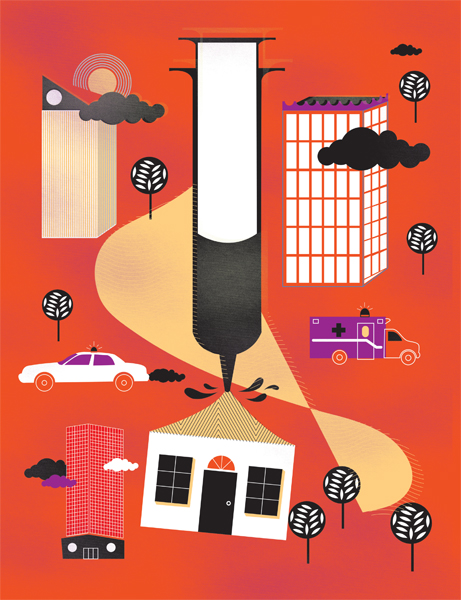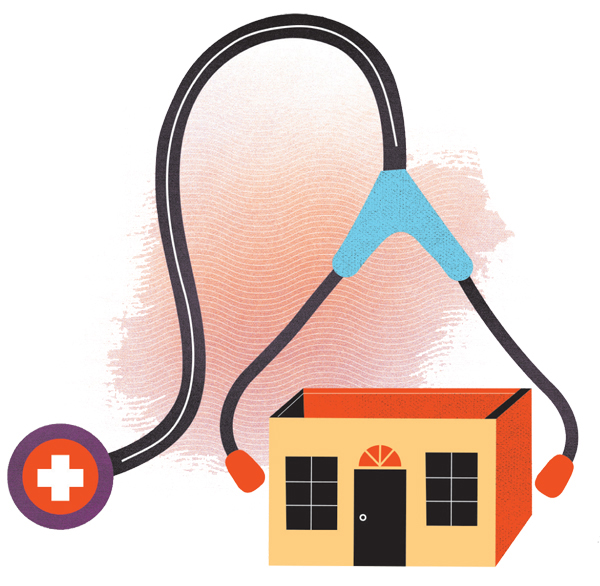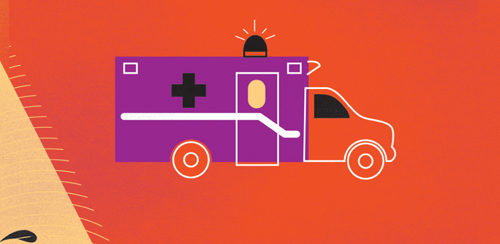October 8, 2015
A new pilot program at the Royal Alexandra Hospital addresses the root causes of physical and mental health problems for those in the inner city, ensuring long term solutions
For years, Dr. Kathryn Dong treated thousands of patients on the frontlines of hospital emergency departments. From stab wounds to car accidents, she had seen it all, but during her time as an ER physician she also realized that Edmonton’s inner city community uses a disproportionately high amount of medical resources.
“I see so much trauma, so much violence, so much substance use, and so much that I think is preventable if things were different for some of our patients,” Dong says. “Ever since I started working in the inner city I knew we had to do better at the Royal Alexandra Hospital (RAH).”
This realization started Dong on the path to explore the relationship between emergency visits and social issues such as housing, poverty, and addiction. After completing her Masters in Population Health in 2007, where she studied the impact of opioid overdoses on Edmonton communities, Dong teamed up with Dr. Ryan Cooper, an infectious disease physician. Together they applied for funding from the Royal Alexandra Hospital Foundation to set up the Edmonton Inner City Health Research and Education Network (EICHREN) in 2008.

EICHREN’s goal was to research ways to improve inner city patients’ healthcare experience. To do that, Dong and Cooper knew that the patients’ themselves needed to be closely involved. “There is time when I’m suturing a patient up in the emergency department that I can spend talking about the weather or the Oilers, or I can use it to talk about the fact you were hit in the head with a beer bottle and now you’re in the emergency department with sutures and maybe there’s something more to that story we should explore.”
And explore she did. Through EICHREN’s research, Dong and her team conducted a series of one-on-one survey sessions with patients in their care. Through the surveys the patients made two things very clear: 1) underlying social factors contribute to emergency room use; 2) patients feel that hospitals are an appropriate setting to discuss these sensitive issues.
At the end of EICHREN’s pilot period, the RAH Foundation asked Dong to submit a proposal for the next steps of the project. The Royal Alexandra Hospital’s Inner City Health and Wellness Program (ICHWP) is the result.
Since opening on July 14, 2014, the $3.5 million, three-year pilot project has moved forward with a three prong approach to address the massively complex issue of inner city health.
THE CLINICAL ARM
The Clinical arm is managed by a three-member team with a staff of five rotating physicians, a full-time nurse practitioner and a full-time social worker, who provide frontline services through the Addiction Recovery and Community Health (ARCH) Team.
Located in the Community Services Centre on the RAH campus, the ARCH Team has served 488 individual patients for a total of 1,066 interactions as of March 1, 2015.
What makes the work being done through ARCH so unique are its partnerships with other community organizations to help address the social issues facing its patients.
Boyle McCauley Health Centre (BMHC) jumped on board at the beginning and were involved in the design of the program. Both organizations share patients and have created a consent-based knowledge sharing arrangement that makes it easier to access and update medical records of mutual patients. The agencies touch base every Wednesday to discuss their patients’ progress, develop discharge plans, book follow up appointments, and track who is prescribing which medications to whom. BMHC is also enabling Dong and her team to submit new patient referrals to the centre’s physicians.
“That’s been unbelievably valuable,” Dong says adding that BMHC is one of the only medical centres in the city that will accept patients without ID. Proper identification is a major hurdle facing members of the inner city community, and in order to address the problem ICHWP is working with Human Services and Alberta Health Services to expand an ID program for homeless patients. This program will allow patients to obtain ID more easily, use the hospital as a mailing address and store their ID securely. This opens up access to employment opportunities and several services that require ID including income support programs, and housing which Dong identifies as one of the most important challenges facing the inner city community.
This is where Homeward Trust Edmonton, an organization dedicated to funding and implementing the Province’s 10-year plan to end homelessness in Edmonton, comes in.
Once ICHWP’s clinical team assesses a patient and identifies that homelessness is a contributing factor, they can refer them to Homeward Trust who then helps them find a stable place to live. By approaching the situation from a housing first perspective, the benefits to both the individual and society are far reaching.

“Housing is a human right, and from a tax-payer’s perspective its far cheaper to house and support people in those situations,” says Ashley Eddy from Homeward Trust. “The cost associated with homelessness far exceeds what it costs to have a worker visit a person in their new home, because of the cost on the public system with things like police services or hospitals.”
Dong agrees, adding, “We need to get people off the street before we can deal with their other issues, and that’s a huge challenge for us.”
Housing is the most pressing issue, but a close second is harm reduction. Dong says that it is nave to think that one or two brief interventions will be enough to help someone to stop injecting heroin after 25 years of use. The key is to empower them with the education and resources to use safely, and to do this, ICHWP relies on the expertise of the staff at Streetworks – Edmonton’s needle exchange program.
“Harm reduction is about keeping people as healthy and safe as possible, period,” Marliss Taylor, Streetworks Program Director says. “We are not demanding that people quit drugs in order to receive service – that is unrealistic and cruel in some cases.” The services Streetworks provides go far beyond exchanging needles. The agency is a national leader in opioid overdose prevention, and was the first organization in Canada to introduce community-based Naloxone training in 2005.
Naloxone is an injectable medication that reverses opioid overdoses by knocking opiates off of chemical receptors in the brain. Last year the World Health Organization identified Naloxone as one of the essential medications that people should have access to.
“I think about it in the same way as an EpiPen,” Dong says explaining that it would be malpractice if they treated someone with a severe allergic reaction and didn’t send them home with an EpiPen. “We need to start thinking of this in the same way – if someone comes in who is injecting opiates and they’ve had an overdose and are near death in the emergency department they need to go home with this kind of training.”
RESEARCH ARM
The research team, headed by Dr. Ginetta Salvalaggio from the Department of Family Medicine, is responsible for tracking the outcomes of the program. This is done by monitoring patients’ progress over six and 12 month periods to see how their interaction with the program has affected several different outcomes including their use of Edmonton’s health system.
How successful has ICHWP been? Dong recalls a female patient who entered the program in its early stages. For privacy reasons we’ll refer to her as Anon and must omit identifying details. Anon moved to Canada as a teenager with her substance-using parents. Because of her parents’ addictions, Anon was never registered with Canadian authorities and as a result never received proper ID – on paper she didn’t exist. Anon quickly became homeless and began working in the sex trade to support her addictions.
“HARM REDUCTION IS ABOUT KEEPING PEOPLE AS HEALTHY AND SAFE AS POSSIBLE, PERIOD…”
It was this lifestyle that led to multiple admissions to the RAH for withdrawalrelated seizures and several accidents where she was hit by cars. For the seizures she’d be admitted to internal medicine and meet with a social worker. For the car-related trauma she’d be admitted to surgery and meet with a different social worker. Only focusing on her immediate needs while she was admitted to hospital meant that the complex underlying social issues leading to Anon’s admittance were not being fully addressed. That’s until Dong and the ARCH Team stepped in after Anon was referred to them during a particularly prolonged hospital stay.
“It was very predictable that she was going to be back in another week having been hit by another car or something horrible,” Dong recalls. “Our team was able to provide continuity – she would see our social worker every time she was admitted, she would see our nurse practitioner, our physician, we all became very involved in her care.”
Thanks to their efforts, Anon is close to receiving official ID, and has moved into a stable housing situation, which is enabling her to begin addressing her addictions. In short, Anon is incredibly fortunate that the Royal Alex was piloting a program like ICHWP.
However, Dong admits there’s still a lot of work to be done to get everyone on the same page and that’s where ICHWP’s third and final arm comes into play.
EDUCATION ARM
The education team is still in its building phase and is where Edmonton Community Foundation (ECF) saw a great opportunity to support this innovative pilot project.
Through its Community Grants Program, ECF provided $40,000 in funding to hire a knowledge translator and a peer outreach coordinator for ICHWP.
The knowledge translator will coordinate electives within the ICHWP for medical students and residents, because, as Dong explains, “it’s super important to inspire people early to do this type of work and give them the skills to do it.”

The translator will develop programming that offers voluntary educational sessions to patients to help fill down-time during their hospital stays. These sessions might focus on things like addiction management and harm reduction. However, Dong notes that the patients themselves will play a big role in identifying the types of services they’ll receive through group and information sessions.
Dong says that working with patients to develop the program is key in bridging the culture gap between the hospital and the streets. Patients who live on the streets can experience severe “culture shock” when they enter a hospital environment that has a different set of rules, expectations and even a different language. This can lead to aggravated situations and it will be part of the peer outreach coordinator’s job to help bridge the gap.
“If you’re downtown and something happens you get bigger, you get more aggressive, you use a different language that really doesn’t translate well in a hospital setting but that’s what you’re used to, that’s how you survive,” Dong says.
Hospitals can make people feel uncomfortable. But doctors can also feel uncomfortable venturing into new territory including asking patients about social factors that may have led to their admittance.
Dong admits that there’s a strong debate about whether it’s a doctor’s job to address the underlying social issues leading to ER visits.
“One of our docs, when we were setting up this program, said, ‘well I can ask all the questions you want about whether they smoke crack or inject heroin, but I have no idea what to do with the answer,'” Dong recalls, noting that she sympathizes with her colleague. “We’re not trained to ask about these other things.”
But that’s a big part of what ICHWP is trying to change. By bringing the community together with a focus on care, research and education, ICHWP is taking the first steps to revolutionizing the way doctors, patients and community stakeholders view, practice and support inner city medicine.